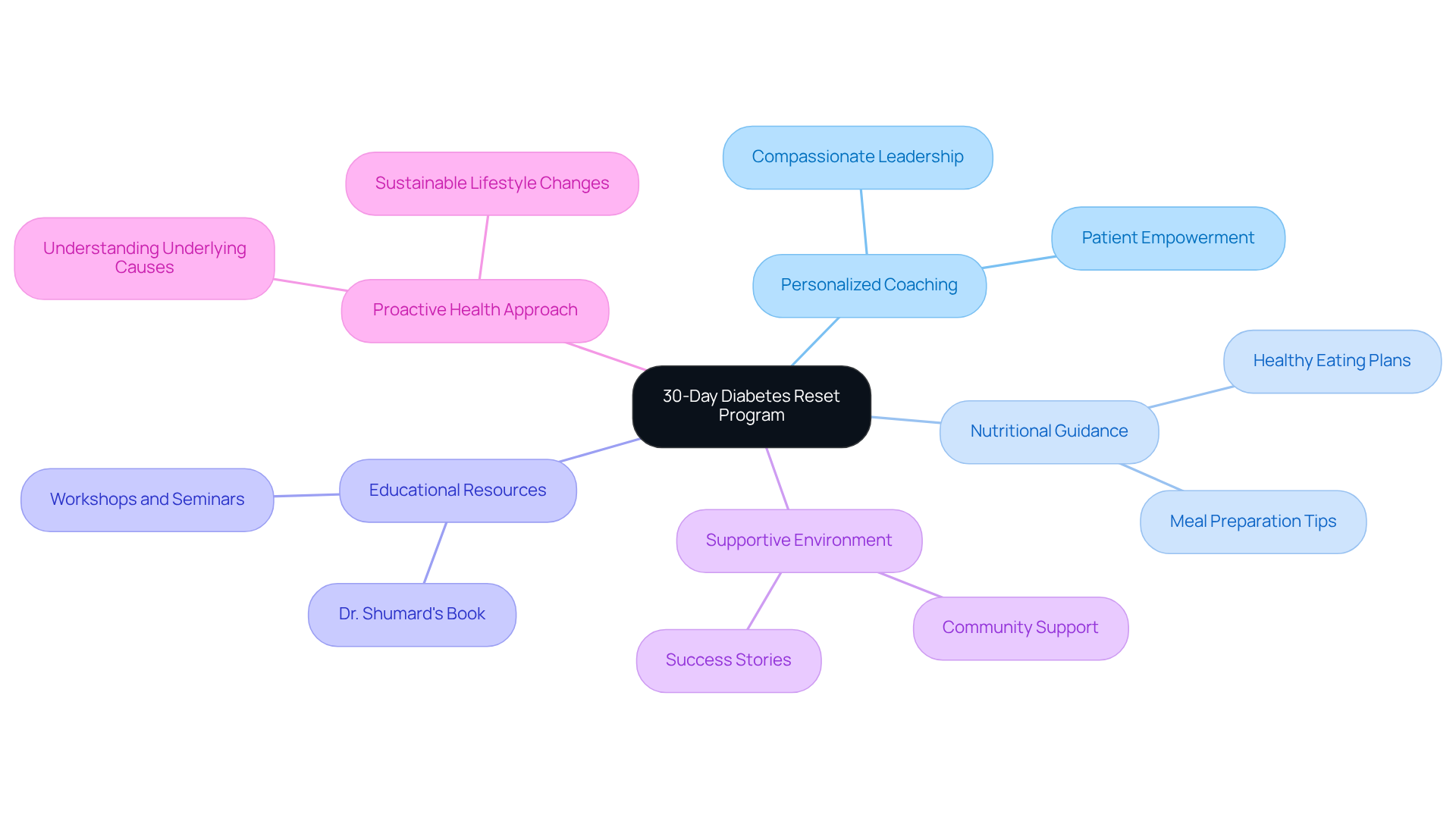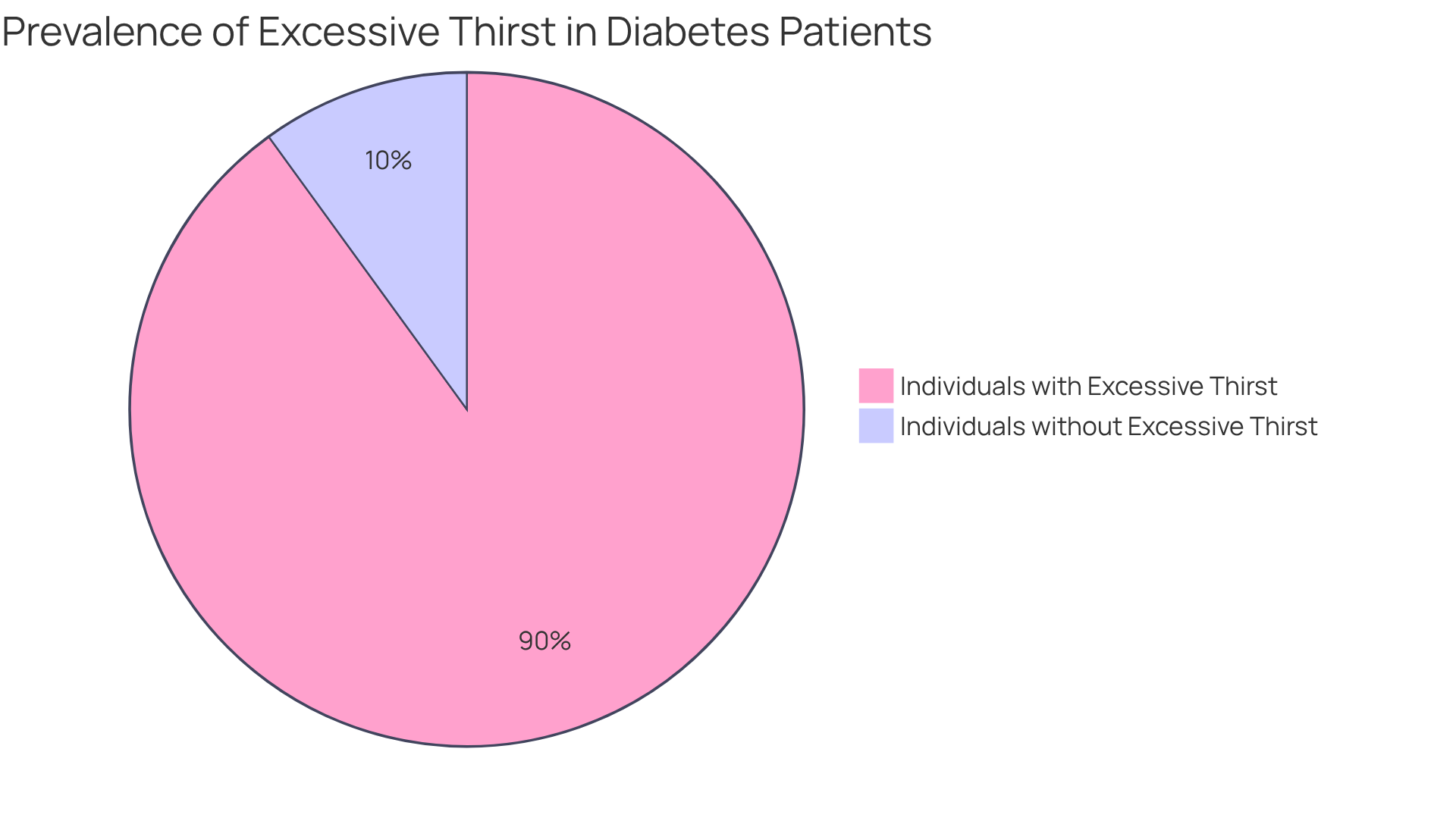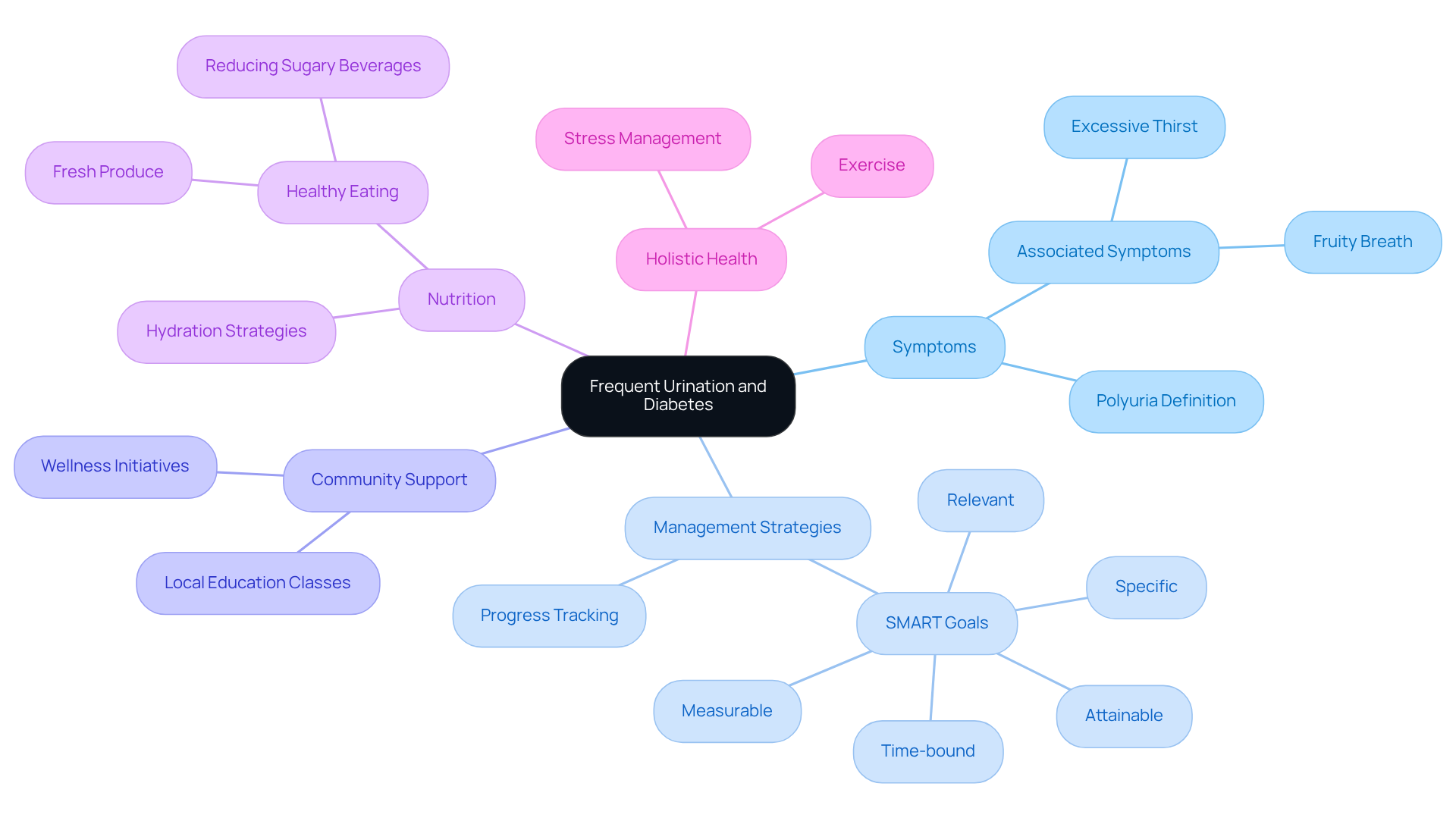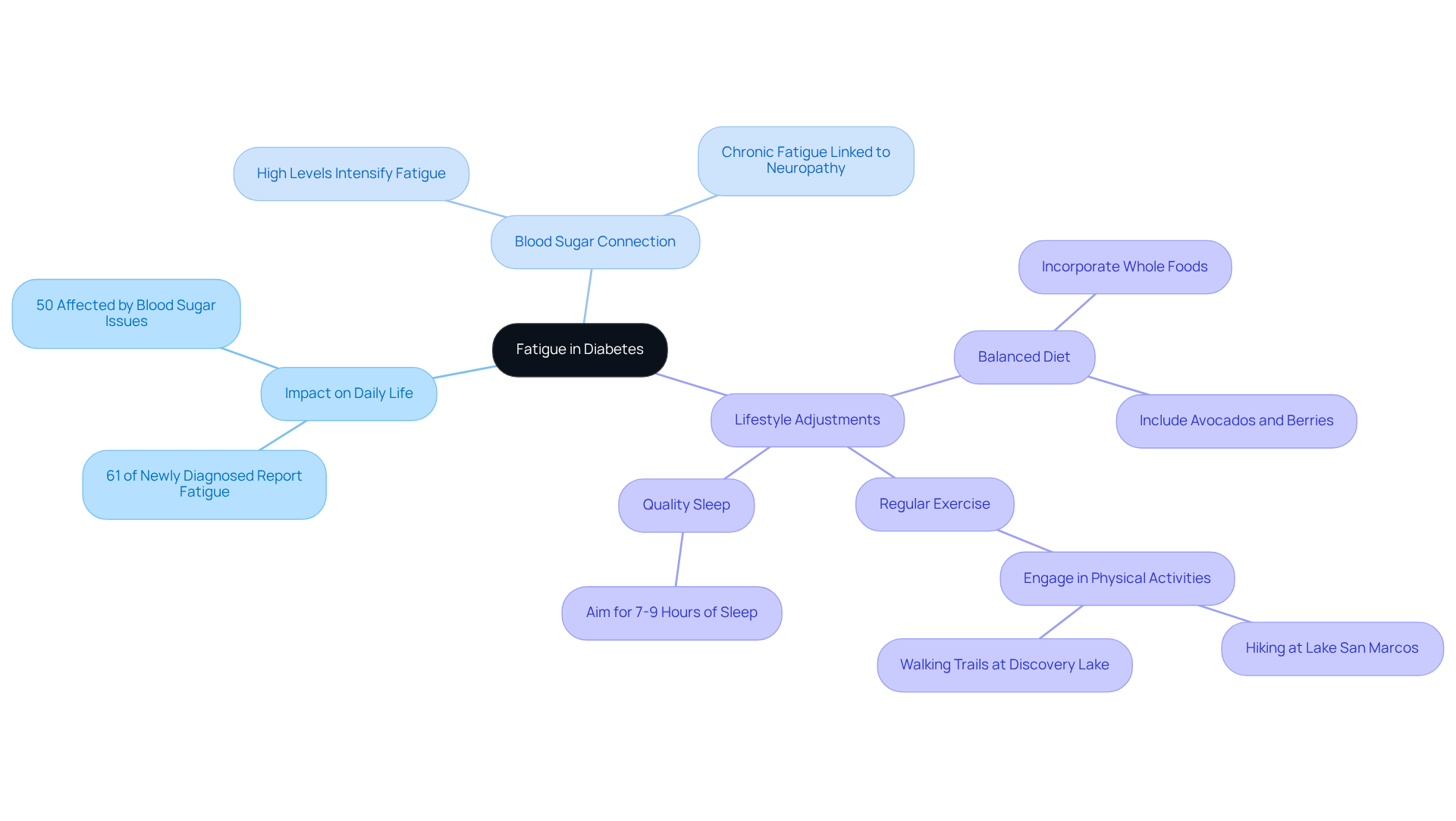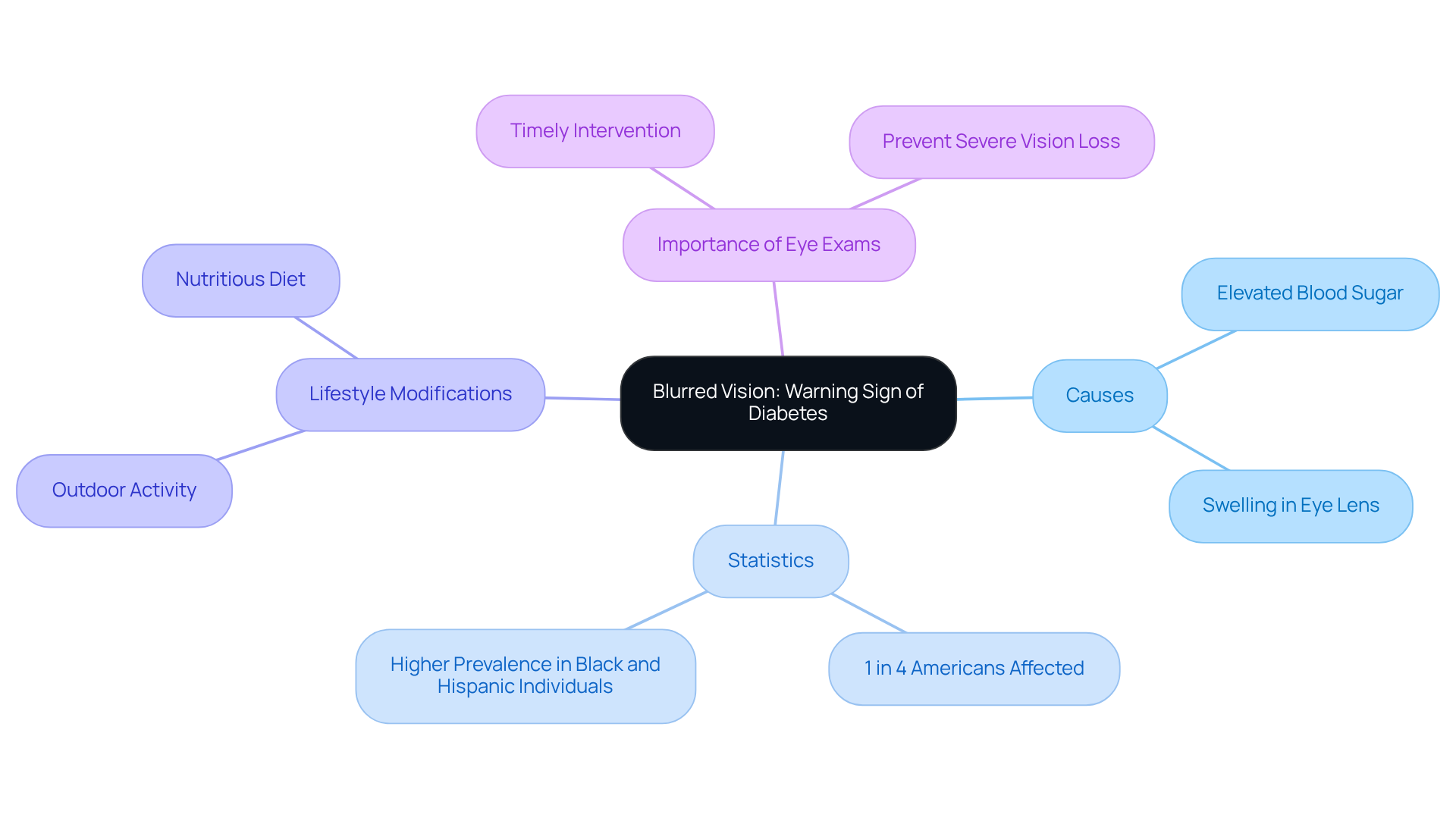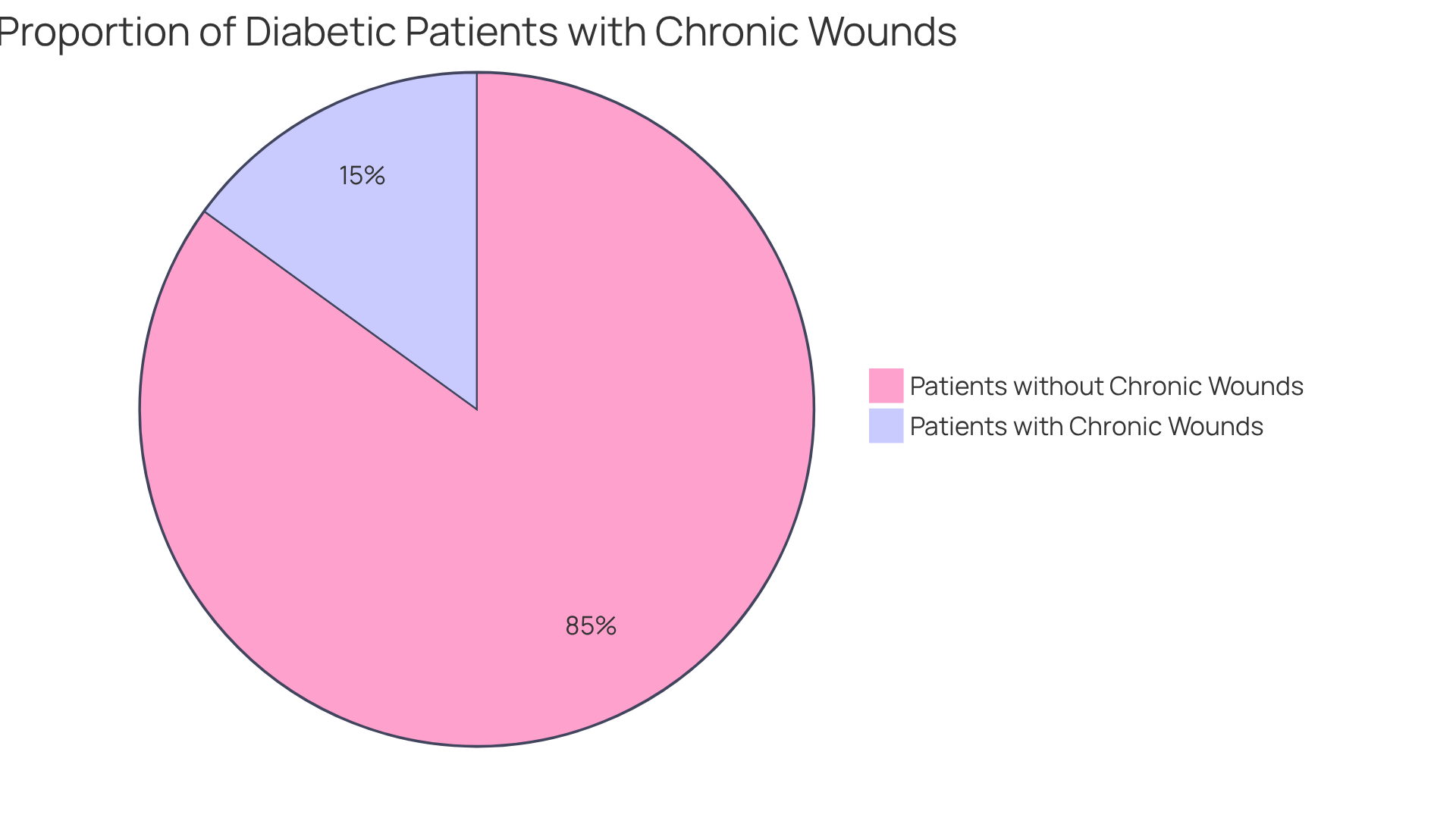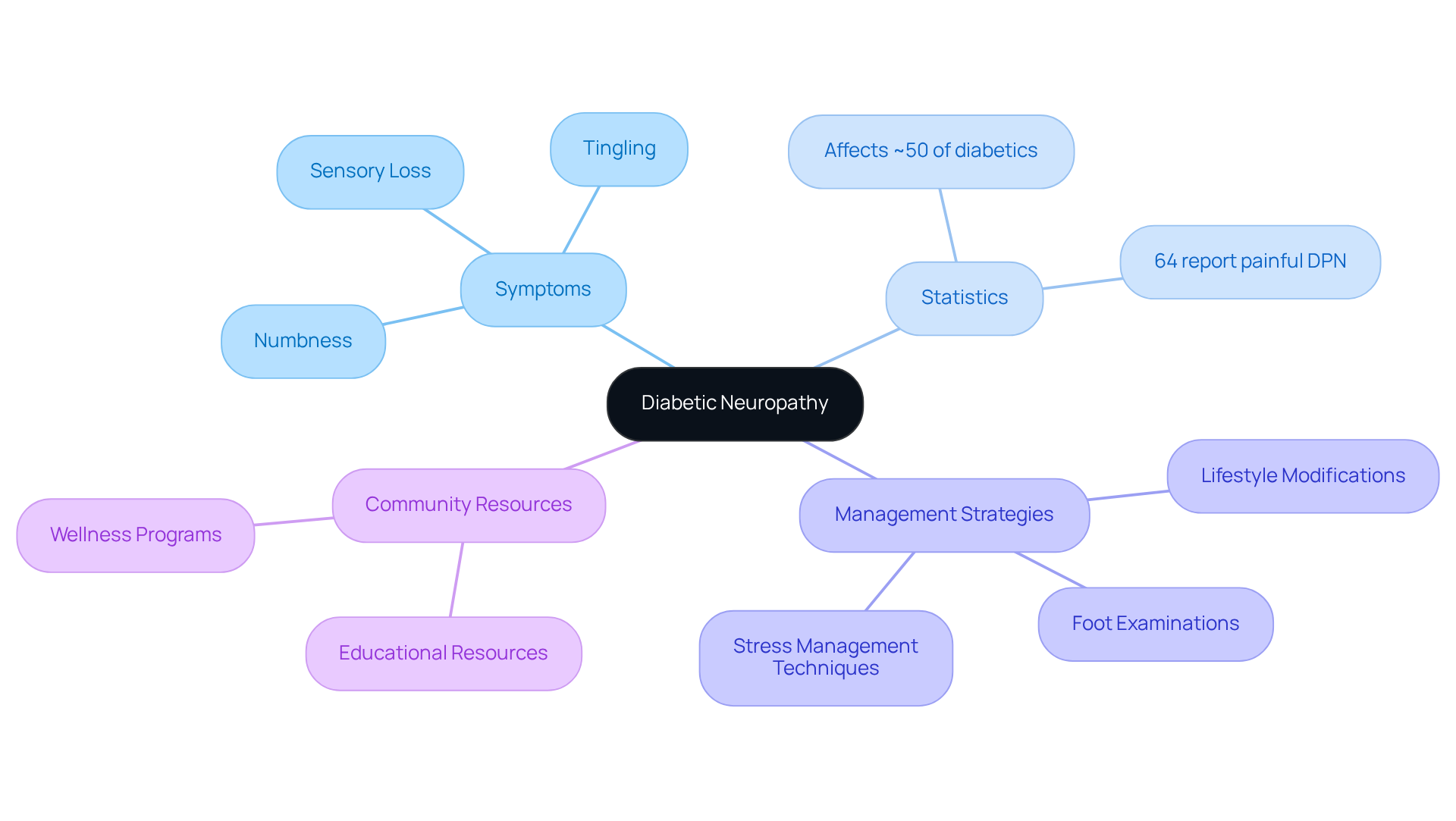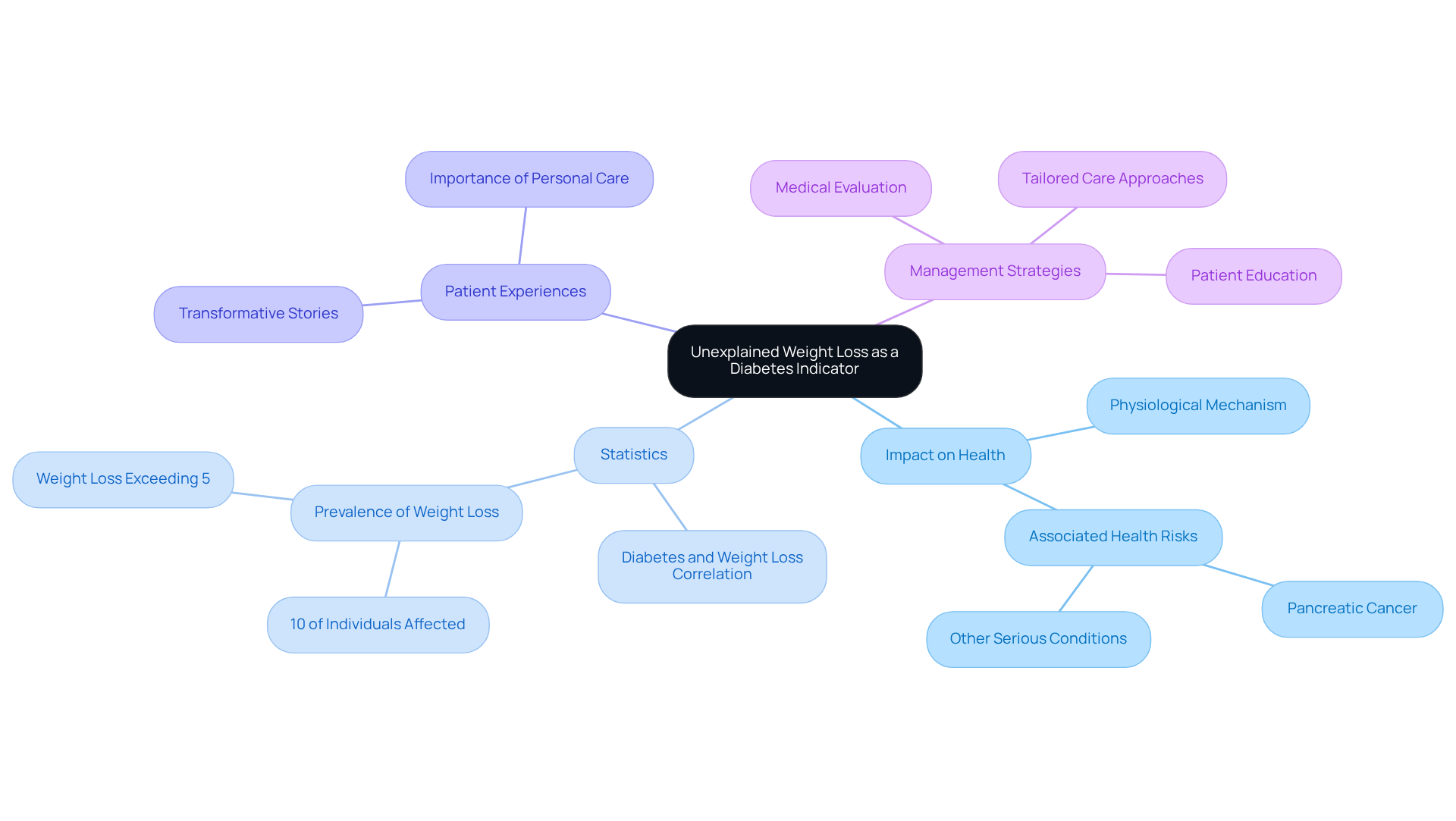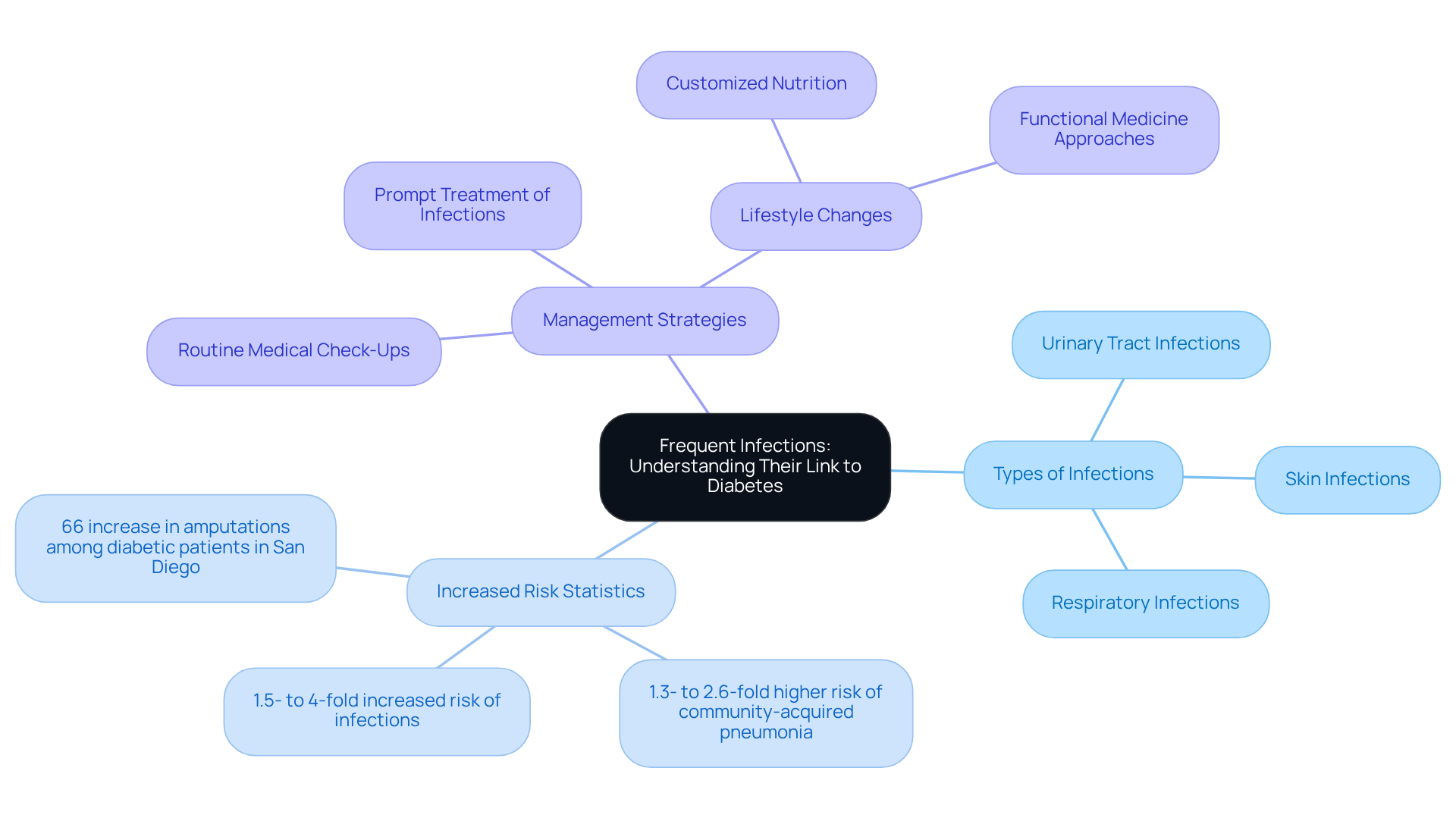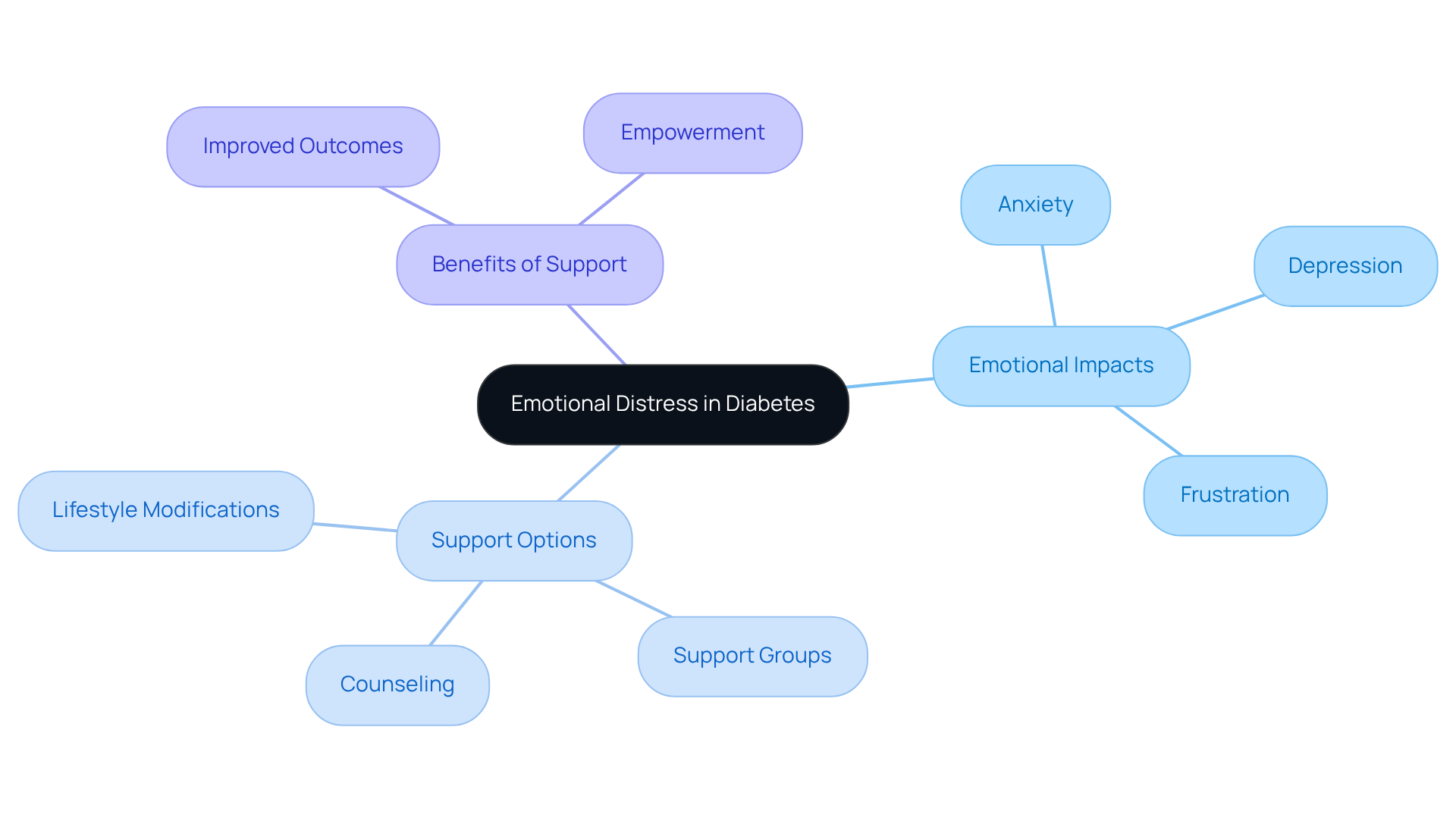Overview
This article highlights the important symptoms of type 1 and type 2 diabetes that individuals should be aware of. These symptoms include:
- Excessive thirst
- Frequent urination
- Fatigue
- Blurred vision
- Slow-healing sores
- Tingling and numbness
- Unexplained weight loss
- Frequent infections
- Emotional distress
It’s crucial to recognize that each of these symptoms can significantly impact daily life. By understanding these signs, you can take proactive steps toward your health.
Many patients find that early recognition of these symptoms is essential for effective management. For instance, excessive thirst and frequent urination can be alarming, but they serve as important signals from your body. Fatigue and blurred vision can also hinder your daily activities, making it vital to address these concerns promptly.
Emotional distress is often overlooked, yet it plays a significant role in the overall well-being of those living with diabetes. Acknowledging these feelings is the first step toward finding support and resources. Remember, you are not alone in this journey.
By exploring these symptoms in detail, we emphasize the importance of early recognition and management. Taking action can prevent complications and improve overall health outcomes. If you resonate with any of these experiences, consider reaching out for support or exploring programs like the 30-Day Diabetes Reset. Your health journey is important, and there are resources available to help you thrive.
Introduction
Recognizing the symptoms of diabetes is not just important; it’s a vital step toward early intervention and effective management of this widespread condition. With millions of individuals affected globally, understanding the signs of both type 1 and type 2 diabetes can empower you to take charge of your health. This article explores ten key symptoms that everyone should be aware of, illuminating how these indicators can signal underlying health issues. It’s important to recognize that overlooking these symptoms can lead to severe consequences. Therefore, staying informed and proactive about your well-being is essential for a healthier future.
Integrative Wellness Center: 30-Day Diabetes Reset Program for Lasting Health Transformation
Are you struggling with managing your blood sugar levels? The 30-Day Diabetes Reset Program at the Integrative Wellness Center is here to help. This groundbreaking, clinically validated initiative empowers individuals like you with essential tools and knowledge to effectively manage and potentially reverse type 2 glucose intolerance. Led by the compassionate Dr. Jason Shumard, this comprehensive program offers personalized coaching, nutritional guidance, and educational resources designed to help you gain a deeper understanding of your condition and make informed lifestyle changes.
It’s important to recognize that managing diabetes involves understanding the underlying causes, not just addressing the symptoms of diabetes type 1 and 2. By emphasizing overall wellness, our program creates a supportive environment conducive to lasting transformation. Many participants have shared their success stories, highlighting significant advancements in their well-being and showcasing the program’s effectiveness in fostering sustainable lifestyle changes.
With a strong focus on education and empowerment, the program aligns with the latest updates in managing conditions related to blood sugar. This reinforces the significance of a proactive approach to your well-being. We invite you to gain additional insights into how you can improve your health by signing up for our upcoming event. Plus, you’ll receive a complimentary copy of Dr. Shumard’s book on reversing the condition. Together, we can take the first steps towards a healthier future.
Excessive Thirst: A Common Symptom of Diabetes
Intense thirst can be one of the initial symptoms of diabetes type 1 and 2, often stemming from elevated blood sugar levels that lead to more frequent urination. This cycle results in fluid loss, creating a relentless feeling of thirst. Have you ever felt like you’re drinking more water than usual yet still feeling dehydrated? Recognizing this symptom is crucial. Early identification can encourage timely medical consultation and help you make necessary lifestyle adjustments to manage your blood sugar levels effectively.
It’s important to understand that research indicates nearly 90% of individuals with diabetes type 1 and 2 experience symptoms of diabetes type 1 and 2, such as excessive thirst. This highlights the need for awareness and understanding as part of proactive health management. By acknowledging these signs, you can take steps toward a healthier future. Remember, you’re not alone in this journey, and seeking support can make all the difference.
Frequent Urination: Understanding Its Connection to Diabetes
Frequent urination, often referred to as polyuria, can be a challenging symptom of diabetes type 1 and 2 for those managing the condition. When blood sugar levels rise, it’s important to recognize that the kidneys must work harder to filter and absorb excess glucose, which can lead to increased urine production. This condition often results in more frequent trips to the bathroom, especially at night. Understanding this connection is crucial for individuals to monitor their symptoms of diabetes type 1 and 2 and to seek appropriate medical care.
To effectively manage this symptom and enhance overall well-being, consider setting SMART goals—specific, measurable, attainable, relevant, and time-bound. For example, tracking your daily fluid intake and aiming to reduce sugary beverages can help you stay hydrated without negatively impacting your blood sugar levels. Regularly reviewing your progress not only fosters accountability but also allows you to adapt your health goals as your symptoms change.
Many patients find that participating in community wellness initiatives, such as local education classes on blood sugar management in San Marcos, can provide additional support and resources tailored to managing this condition. Additionally, exploring farmers’ markets for fresh, local produce can greatly enhance your nutrition. It’s essential to adopt a holistic approach that includes exercise and stress management. By prioritizing these strategies, you can cultivate a sense of achievement and maintain engagement in your health management journey.
Fatigue: Recognizing Its Role in Diabetes Symptoms
Fatigue is a common struggle for many individuals facing this condition, often stemming from the body’s challenges in effectively utilizing glucose for energy. It’s important to recognize that research indicates up to 61% of newly diagnosed type 2 individuals report experiencing fatigue, which can significantly hinder daily activities. High blood sugar levels can intensify feelings of tiredness and lethargy, emphasizing the need for careful monitoring of blood sugar levels. Many patients find that chronic fatigue affects nearly 50% of those with blood sugar issues, with those experiencing neuropathy reporting even higher levels of fatigue. This highlights the necessity of acknowledging fatigue as a critical part of the symptoms of diabetes type 1 and 2.
By understanding the connection between blood sugar regulation and energy, individuals can make informed adjustments to their diet and exercise routines. Nutritionists emphasize that a balanced diet rich in whole foods—like the seasonal fruits and vegetables available at local farmers’ markets in San Marcos—can help regulate blood glucose levels and boost energy. For example, incorporating avocados and berries into meals can provide essential nutrients that support energy regulation. Patients who embrace a whole-grain-based diet often report improved energy and reduced fatigue. As nutritionist Angelica Bottaro notes, “Fatigue is one of the most common symptoms of diabetes type 1 and 2,” underscoring the need for effective management strategies.
Real-life examples show that those who actively engage in lifestyle changes, such as regular physical activity—like hiking at Lake San Marcos or walking the trails at Discovery Lake—along with maintaining a nutritious diet, experience significant improvements in their energy levels and overall well-being. Furthermore, individuals with blood sugar concerns are encouraged to aim for 7-9 hours of quality rest each night to help manage fatigue effectively. Participating in community wellness programs in San Marcos can provide invaluable support, offering resources and motivation to help people integrate these healthy habits into their daily routines.
Ultimately, recognizing fatigue as one of the symptoms of diabetes type 1 and 2 can empower individuals to take proactive steps in managing their condition, leading to a more vibrant and active lifestyle.
Blurred Vision: A Warning Sign of Diabetes Complications
Blurred vision can often be an early warning sign of diabetes-related complications, particularly diabetic retinopathy. It’s important to recognize that elevated blood sugar levels may lead to swelling in the eye’s lens, resulting in temporary vision changes. If these symptoms are overlooked, they can escalate into more severe conditions that threaten eyesight. Did you know that approximately 1 in 4 Americans aged 40 and older with high blood sugar levels are affected by diabetic retinopathy? This statistic highlights the importance of early detection and management.
If you’re experiencing blurred vision, please seek prompt consultation with your healthcare provider. They can assess your medical management and eye health to ensure you’re on the right path. Many patients find that adopting lifestyle modifications—such as consistent outdoor activity and a nutritious diet rich in local produce—can greatly assist in regulating blood sugar levels and may lower the risk of issues like blurred vision.
It’s crucial to ensure you receive an annual dilated eye exam. Timely intervention can significantly reduce the risk of vision loss. Consistent screening and effective treatment can prevent up to 95% of severe vision loss cases linked to diabetic retinopathy. Remember, taking these steps not only supports your eye health but also empowers you to live a healthier life.
Slow-Healing Sores: A Serious Diabetes Symptom
Living with diabetes can be incredibly challenging, especially when it comes to managing wounds that heal slowly. Many individuals find themselves struggling with this issue, which often stems from compromised circulation and nerve damage. Elevated blood sugar levels can disrupt the body’s natural healing processes, making even minor cuts and scrapes take much longer to heal than they should.
It’s important to recognize that approximately 15 percent of all diabetic patients develop chronic wounds, with around 1.5 million people experiencing diabetic ulcers each year. This delay in healing not only increases the risk of infections but also raises the likelihood of severe complications, including amputations. Many patients find that understanding these risks empowers them to take action. In fact, with routine neuropathy testing and education on proper wound care, diabetes-related amputations could potentially be reduced by 50 percent.
Therefore, it is crucial for individuals to monitor their wounds closely. If healing does not progress as expected, seeking medical attention promptly can make all the difference. As wound care experts emphasize, addressing these concerns early can greatly enhance outcomes and improve overall health management. Remember, you are not alone in this journey, and taking proactive steps can lead to better health and a brighter future.
Tingling and Numbness: Recognizing Nerve Damage in Diabetes
Tingling and numbness, particularly in the hands and feet, can be distressing symptoms of diabetic neuropathy, a common complication that arises from prolonged high blood sugar levels. This nerve damage often leads to significant sensory loss, which can increase the risk of injuries and complications.
It’s important to recognize that studies indicate diabetic neuropathy affects around 50% of individuals with diabetes, with a higher prevalence in those with type 2 compared to type 1. Neurologists emphasize that nerve damage in individuals with elevated blood sugar can lead to severe consequences, including chronic pain and disability. For instance, many patients find that 64% of those with high blood sugar levels report experiencing painful diabetic peripheral neuropathy (DPN), underscoring the critical need for early detection and management.
If you are experiencing these symptoms, please consult your healthcare provider for a thorough assessment and potential management strategies. This may involve lifestyle modifications, such as engaging in regular outdoor exercise, which is easily accessible in San Marcos, CA. Focusing on a balanced diet rich in local produce can also help regulate blood sugar levels effectively. Community wellness programs can provide invaluable support, offering resources tailored to managing diabetes. Additionally, stress management techniques, such as yoga and mindfulness practices, can play a crucial role in enhancing overall health.
Regular foot examinations and education on self-care practices, such as monitoring blood sugar levels and examining your feet daily, are essential to prevent complications associated with diabetic neuropathy. Remember, you are not alone in this journey, and there are many resources available to support you.
Unexplained Weight Loss: A Key Diabetes Indicator
Unexplained weight loss can be a significant indicator of a serious condition, especially in type 1 cases. When the body doesn’t have enough insulin to utilize glucose for energy, it compensates by breaking down fat and muscle, leading to rapid weight loss. This isn’t just a side effect; it’s a critical symptom related to the symptoms of diabetes type 1 and 2 that deserves immediate medical evaluation.
It’s important to recognize that approximately 10% of individuals with this condition experience unexplained weight loss, often exceeding 5% of their body weight within six to twelve months. Such weight loss can signal the onset of blood sugar disorders or other serious health issues, including the symptoms of diabetes type 1 and 2, making it essential for patients to seek prompt medical attention. Recognizing the symptoms of diabetes type 1 and 2 can lead to earlier diagnosis and more effective management of blood sugar levels, ultimately improving patient outcomes.
Many patients find that sharing their experiences can be enlightening. One patient, who battled with blood sugar issues for a decade, expressed, “I was on 2 different meds that weren’t working and was told that I needed insulin. When I started this program, the Doctor gave great personal attention and care in helping fix my condition. I have lost 55 lbs and my A1C started at 9.1; after 8 months, it is now 5.7.” Such transformative experiences underscore the importance of suitable care and education regarding this condition, particularly in identifying and addressing symptoms of diabetes type 1 and 2, including unexplained weight loss.
Moreover, considering the concerning statistics about hospital safety, it’s crucial to highlight the significance of tailored care in managing blood sugar conditions. By addressing these symptoms and seeking the right support, patients can embark on a journey toward better health and well-being.
Frequent Infections: Understanding Their Link to Diabetes
Individuals facing sugar metabolism challenges often find themselves at a heightened risk of frequent infections, which can stem from compromised immune function and impaired circulation. It’s important to recognize that elevated blood sugar levels can significantly hinder the body’s ability to combat infections, making vigilant health monitoring essential. Statistics reveal that those with this condition may experience a 1.5- to 4-fold increased risk of infections, including:
- Urinary tract infections
- Skin infections
- Respiratory infections
Many patients find that they are particularly susceptible to community-acquired pneumonia, facing a 1.3- to 2.6-fold higher risk of this condition, which can lead to severe complications and increased mortality rates.
This situation is especially concerning given the alarming rise in amputations among diabetic patients in San Diego, which has surged by over 66%. Prompt medical attention is crucial for effectively managing these infections, as untreated conditions can exacerbate glycemic control and lead to further health complications, including the risk of limb loss. Understanding the connection between blood sugar issues and immune function is vital; chronic hyperglycemia adversely affects innate cell-mediated immunity, complicating the body’s response to infectious threats.
As Dr. Jason Shumard insightfully points out, “Infections are not usually regarded as conventional complications of the condition, yet they are a significant cause for hospitalizations among this group.” Moreover, financial obstacles and shortcomings in diabetic care may hinder patients from seeking prompt treatment, worsening their medical issues. Therefore, proactive management strategies are essential. These include:
- Routine medical check-ups
- Prompt treatment of infections
- Lifestyle changes such as customized nutrition and functional medicine approaches
By embracing these strategies, individuals living with this condition can prevent serious complications and enhance their overall well-being.
Emotional Distress: The Overlooked Impact of Diabetes
Living with this condition can often lead to significant emotional distress, manifesting as anxiety, depression, and frustration. It’s important to recognize that the continuous demands of regulating blood sugar levels, combined with the worry of potential complications, can deeply affect mental well-being. Recent research indicates that approximately 18% to 40% of individuals with this condition experience notable emotional distress, highlighting the critical need for effective mental support.
Have you considered seeking assistance through:
- Counseling
- Support groups
- Lifestyle modifications that can enhance your emotional well-being?
Tackling these emotional challenges is essential not only for your overall health but also plays a significant role in managing blood sugar effectively. Many patients find that incorporating mental wellness support into their chronic disease management leads to improved outcomes. They often express feeling more empowered and capable of handling their condition.
As health professionals emphasize, recognizing the emotional aspects of the symptoms of diabetes type 1 and 2 is key to fostering a holistic approach to treatment.
Conclusion
Recognizing the symptoms of diabetes type 1 and 2 is crucial for early intervention and effective management. It’s important to understand that symptoms such as:
- Excessive thirst
- Frequent urination
- Fatigue
- Blurred vision
- Slow-healing sores
- Tingling sensations
- Unexplained weight loss
- Frequent infections
- Emotional distress
can signal underlying health issues. Each symptom serves as a vital indicator, reinforcing the importance of awareness and proactive health measures.
Many patients find that understanding these symptoms empowers them to seek timely medical advice and make necessary lifestyle adjustments. Programs like the 30-Day Diabetes Reset provide essential support and education, allowing participants to manage their condition more effectively. Furthermore, addressing emotional well-being is equally important, as it plays a significant role in overall health and diabetes management.
Ultimately, the journey toward better health involves recognizing symptoms, seeking support, and embracing lifestyle changes that can lead to lasting transformation. By prioritizing awareness and education, individuals living with diabetes can take significant steps toward a healthier future, improving their quality of life and reducing the risk of complications. Engaging with community resources and wellness programs can further enhance this journey, fostering a supportive environment for those affected by diabetes. Remember, you are not alone on this path; there are resources and people ready to help you every step of the way.
Frequently Asked Questions
What is the 30-Day Diabetes Reset Program at the Integrative Wellness Center?
The 30-Day Diabetes Reset Program is a clinically validated initiative designed to help individuals manage and potentially reverse type 2 glucose intolerance. It offers personalized coaching, nutritional guidance, and educational resources to empower participants in understanding their condition and making informed lifestyle changes.
Who leads the 30-Day Diabetes Reset Program?
The program is led by Dr. Jason Shumard, who provides compassionate support and guidance throughout the initiative.
What are the main focuses of the 30-Day Diabetes Reset Program?
The program emphasizes understanding the underlying causes of diabetes, overall wellness, education, and empowerment to create a supportive environment for lasting health transformation.
How does the program help participants manage their diabetes?
Participants receive personalized coaching, nutritional guidance, and educational resources that help them understand their condition better and make sustainable lifestyle changes.
What is the significance of recognizing symptoms like excessive thirst and frequent urination in diabetes?
Recognizing symptoms such as excessive thirst and frequent urination is crucial for early identification of diabetes, which encourages timely medical consultation and necessary lifestyle adjustments to manage blood sugar levels effectively.
What is excessive thirst, and how is it related to diabetes?
Excessive thirst is a common symptom of diabetes type 1 and 2, often caused by elevated blood sugar levels leading to more frequent urination and fluid loss, resulting in a constant feeling of thirst.
What is frequent urination, and how does it connect to diabetes?
Frequent urination, or polyuria, occurs when the kidneys filter and absorb excess glucose due to rising blood sugar levels, leading to increased urine production and more trips to the bathroom.
What strategies can individuals use to manage symptoms of diabetes?
Individuals can set SMART goals, track fluid intake, reduce sugary beverages, participate in community wellness initiatives, and adopt a holistic approach that includes exercise and stress management.
How can community support benefit those managing diabetes?
Community support, such as local education classes on blood sugar management and access to fresh produce from farmers’ markets, can provide additional resources and encouragement for individuals managing diabetes.
What additional resources are offered to participants in the 30-Day Diabetes Reset Program?
Participants who sign up for the program will receive a complimentary copy of Dr. Shumard’s book on reversing the condition, along with insights on improving their health.
